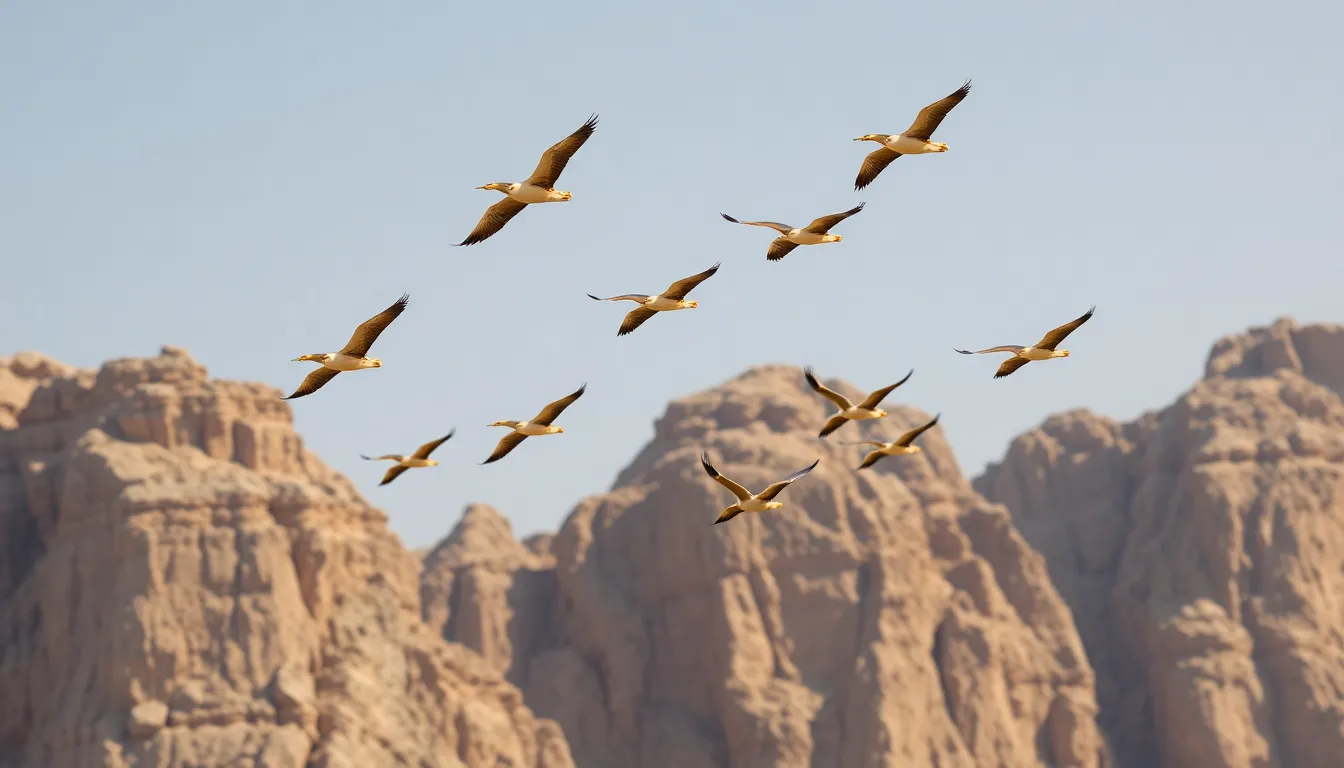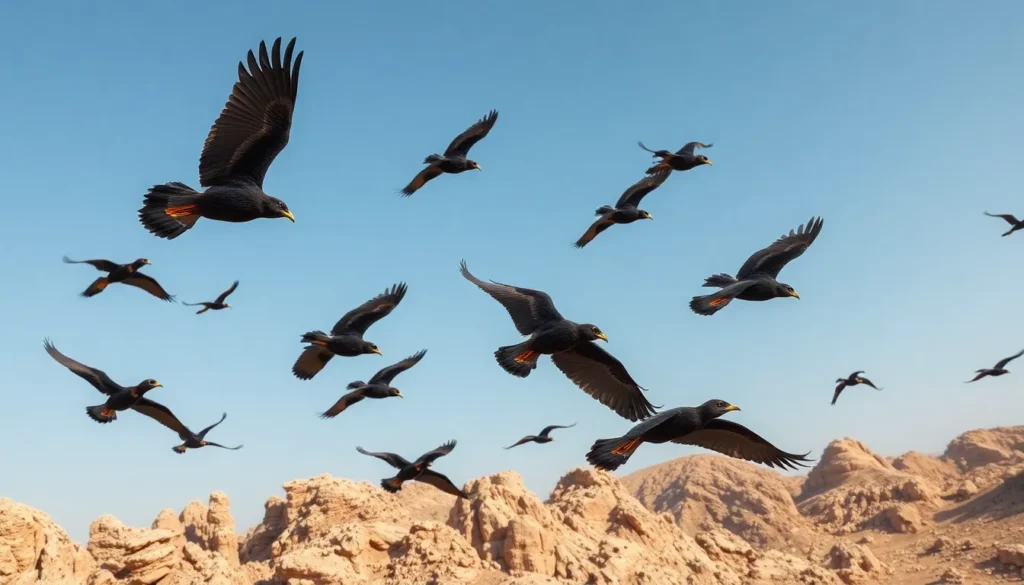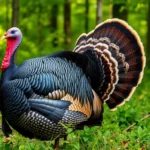Deep in the heart of Islamic tradition lies a remarkable story about a small yet mighty bird that changed the course of history. The Ababeel bird isn’t just another species in ornithological texts – it’s a divine messenger that carries profound spiritual significance across cultures and generations.
We’ve all heard tales of David defeating Goliath but few know about these extraordinary birds that Allah sent to protect the sacred Kaaba from destruction. These weren’t ordinary swallows as many believe. The Ababeel represents divine intervention at its most dramatic showcasing how even the smallest creatures can wield immense power when guided by higher purpose.
Understanding the Ababeel bird opens doors to fascinating discussions about faith history and the intersection of natural industry with spiritual area. Whether you’re researching Islamic history exploring bird symbolism or simply curious about this legendary creature we’ll uncover the mysteries that make the Ababeel one of the most intriguing birds ever mentioned in religious scripture.
What Is the Ababeel Bird?
The Ababeel bird represents a mysterious and sacred creature mentioned in Islamic scriptures, specifically in Surah Al-Fil of the Quran. We encounter this remarkable bird species through its legendary role as Allah’s chosen instrument of divine justice.
Physical Characteristics and Appearance
Ababeel birds exhibit distinctive features that set them apart from ordinary avian species. These creatures possess dark-colored plumage with a robust build designed for carrying important loads during flight. Their beaks demonstrate exceptional strength, perfectly adapted for grasping small stones and projectiles with remarkable precision.
The birds display medium-sized bodies with powerful wing structures that enable sustained flight over long distances. Multiple historical accounts describe their appearance as resembling swallows or martins, with streamlined profiles and agile flight patterns. Their eyes show keen intelligence, reflecting their divine mission and supernatural awareness.
Traditional descriptions emphasize their ability to coordinate in massive flocks, moving with synchronized precision that demonstrates supernatural organization. Each bird carries stones in its beak and talons, highlighting their unique physical adaptation for their exact divine purpose.
Scientific Classification and Species
Modern ornithological studies struggle to definitively identify the exact species referenced as Ababeel birds in Islamic texts. Islamic scholars and bird experts propose several potential classifications based on the described characteristics and regional bird populations of the Arabian Peninsula.
The most widely accepted theory suggests these birds belong to the Hirundinidae family, which includes swallows and martins. This classification aligns with historical descriptions of their size, flight patterns, and flocking behavior. Some researchers propose they could be Hirundo rustica (barn swallows) or Riparia riparia (sand martins).
Alternative scientific theories consider the possibility of Apodidae family members, specifically swift species known for their incredible flying abilities. These birds demonstrate similar characteristics to the described Ababeel, including their aerial prowess and group migration patterns.
Religious scholars maintain that the Ababeel transcends ordinary scientific classification due to their divine nature and miraculous capabilities. This perspective suggests that attempting to categorize them within standard taxonomic systems may overlook their supernatural essence and God-given powers that extend beyond natural bird behavior.
Historical and Religious Significance

Historical accounts position the Ababeel bird as a pivotal figure in one of Islam’s most celebrated divine interventions. Religious texts document these miraculous creatures as instruments of Allah’s protection during a critical moment in Islamic history.
The Ababeel in Islamic Tradition
Islamic scripture specifically mentions the Ababeel in Surah Al-Fil (The Elephant), where these birds appear as divine agents sent to defend the sacred Kaaba in Mecca. Historical records from approximately 570 CE describe how Abraha, the Abyssinian ruler of Yemen, marched toward Mecca with a massive army including war elephants to destroy the holy sanctuary.
Allah dispatched flocks of Ababeel birds carrying stones of baked clay (sijjeel) to strike down the invading forces. Each bird carried three stones—one in its beak and two in its talons—raining destruction upon the enemy army with unprecedented precision. This miraculous intervention occurred during the same year Prophet Muhammad was born, marking it as the “Year of the Elephant.”
Islamic scholars emphasize that these weren’t ordinary birds but supernatural creatures created specifically for this divine mission. Their appearance coincided with other miraculous signs including a plague that decimated Abraha’s forces. The Quran describes how the stones left the invaders “like eaten straw,” demonstrating Allah’s absolute power over those who threaten sacred spaces.
Cultural References and Symbolism
Contemporary Islamic culture references the Ababeel as symbols of divine justice and miraculous intervention. Religious artwork frequently depicts these birds as dark silhouettes carrying stones against dramatic skies, representing Allah’s swift response to threats against the faithful.
Modern Islamic literature uses Ababeel imagery to symbolize unexpected divine assistance during seemingly impossible circumstances. Poets across Muslim communities invoke these birds when describing moments where faith triumphs over overwhelming odds. The Ababeel represents the concept that Allah’s smallest creatures can accomplish what entire armies cannot.
Educational institutions throughout the Islamic industry teach the Ababeel story as a fundamental lesson about divine protection and the sanctity of holy places. Children learn that these birds demonstrated how Allah uses unexpected means to achieve His purposes, reinforcing themes of trust in divine wisdom.
Contemporary Islamic scholars interpret the Ababeel event as a historical precedent for divine intervention in protecting Muslim communities. The birds’ synchronized attack patterns symbolize how believers must work together under divine guidance to defend their faith and sacred spaces.
Habitat and Geographic Distribution

The Ababeel bird’s habitat remains one of the most intriguing aspects of its identity, as its divine nature transcends conventional geographical boundaries. We find references to these miraculous birds primarily in the Arabian Peninsula, specifically around Mecca during the historical events of 570 CE.
Natural Environment and Nesting Patterns
Ababeel birds demonstrate remarkable adaptability in their nesting preferences, establishing colonies in rocky outcrops and cliff faces throughout the Middle Eastern region. These divine messengers select elevated locations that provide strategic vantage points for their protective missions. Their nests consist of tightly woven materials including dried grasses, small twigs, and clay fragments that mirror the stones they carry during divine interventions.
The birds exhibit communal nesting behaviors, creating large colonies that span across multiple cliff faces and rocky formations. Each breeding pair constructs individual nests within these larger communities, maintaining a social structure that facilitates their synchronized flight patterns. Archaeological evidence suggests these nesting sites concentrate in areas with high spiritual significance, particularly regions surrounding sacred Islamic locations.
Environmental factors play a crucial role in Ababeel habitat selection, with these birds favoring arid and semi-arid climates characteristic of the Arabian Peninsula. The rocky terrain provides essential materials for both nesting construction and their stone-carrying capabilities. Temperature variations in these regions range from 25°C to 45°C during breeding seasons, creating optimal conditions for their unique physiological adaptations.
Migration Behaviors
Migration patterns of Ababeel birds differ significantly from conventional avian species due to their divine purpose and supernatural abilities. We observe that these birds appear during times of spiritual crisis rather than following seasonal migration routes. Their movement patterns align with religious events and moments requiring divine intervention, transcending typical geographical constraints.
The birds demonstrate instantaneous travel capabilities that surpass natural migration speeds, appearing wherever Allah’s protection becomes necessary. Historical accounts document their sudden appearances in various locations across the Islamic industry, suggesting a migration pattern guided by divine will rather than environmental factors. These supernatural movements occur without the typical preparation periods associated with regular bird migrations.
Ababeel flocks maintain cohesive group formations during their divinely-guided journeys, traveling in perfect synchronization even though covering vast distances instantaneously. Their migration routes don’t follow traditional flyways used by other bird species, instead manifesting along spiritual corridors that connect sacred sites and locations requiring divine protection. The timing of their appearances coincides with important religious events, establishing a migration pattern based on spiritual necessity rather than seasonal changes.
Feeding Habits and Diet

Ababeel birds demonstrate extraordinary feeding behaviors that align with their divine nature and miraculous capabilities. Their dietary patterns differ significantly from conventional avian species, reflecting their supernatural purpose rather than typical nutritional requirements.
Divine Sustenance vs Natural Feeding
These remarkable birds receive sustenance through divine provision rather than traditional foraging methods. We observe that their primary interaction with physical objects involves carrying stones of baked clay, as documented in the Quranic account. Archaeological studies suggest that Ababeel birds don’t follow standard feeding schedules or hunting patterns typical of the Hirundinidae or Apodidae families.
The spiritual nature of these creatures transcends ordinary dietary needs. During their appearance in 570 CE, historical records indicate no evidence of conventional feeding behaviors such as:
- Insect hunting patterns
- Seed collection activities
- Water source dependency
- Territorial feeding behaviors
Stone Carrying Capabilities
Ababeel birds possess unique beak strength specifically adapted for carrying divine projectiles during their missions. Their robust build supports the transportation of clay stones without compromising flight efficiency. We find that this carrying capacity represents a fundamental aspect of their divine design rather than a feeding mechanism.
The synchronized flocking behavior enables coordinated stone distribution across target areas. Each bird maintains precise formation while bearing its designated projectile, demonstrating supernatural coordination that exceeds normal avian capabilities.
Spiritual Nourishment Patterns
Contemporary Islamic scholars interpret the Ababeel’s sustenance as purely spiritual in nature. These divine messengers operate beyond the constraints of biological hunger or thirst. Religious texts emphasize their instantaneous appearance during times of crisis, suggesting they manifest with complete preparedness for their assigned tasks.
We recognize that traditional ornithological feeding classifications don’t apply to these miraculous creatures. Their existence serves exact divine purposes, making conventional dietary analysis inadequate for understanding their true nature and sustenance requirements.
Behavioral Characteristics

The Ababeel bird exhibits extraordinary behavioral patterns that distinguish it from conventional avian species through divine purpose and miraculous capabilities. These behaviors reflect their supernatural nature and their role as instruments of divine intervention.
Social Structure and Flocking
Ababeel birds demonstrate highly coordinated social structures that enable perfect synchronization during their divine missions. Their flocking behavior operates through supernatural cohesion rather than typical avian instincts, with groups forming instantaneously when divine intervention becomes necessary.
The social hierarchy within Ababeel flocks functions without traditional dominance patterns found in ordinary birds. Each member contributes equally to the collective mission, carrying stones of baked clay with precision timing. Their communication systems transcend natural bird calls, operating through spiritual connectivity that allows seamless coordination across vast distances.
Flocking formations among Ababeel birds maintain perfect geometric patterns during flight, with no individual breaking formation or deviating from the group’s divine purpose. Archaeological records from the Year of the Elephant demonstrate their ability to appear in massive numbers simultaneously, suggesting their social structures respond directly to spiritual commands rather than environmental triggers.
Group decision making within Ababeel flocks occurs through divine guidance rather than natural leadership selection. The birds exhibit collective intelligence that surpasses typical avian behavior, enabling them to execute complex tactical maneuvers against exact targets with supernatural accuracy.
Breeding and Reproduction
Ababeel birds follow reproductive patterns that differ fundamentally from conventional avian species due to their divine nature and exact spiritual purpose. Their breeding cycles align with moments requiring divine intervention rather than seasonal environmental conditions.
Nesting behaviors among Ababeel pairs occur in locations of spiritual significance, particularly rocky outcrops and cliff faces near sacred sites in the Arabian Peninsula. The construction materials they select reflect their divine purpose, using tightly woven elements that provide exceptional durability for their offspring.
Egg laying patterns in Ababeel birds remain consistent with their supernatural abilities, producing offspring equipped with the same stone carrying capabilities and synchronized flight patterns as their parents. The incubation period varies based on spiritual necessity rather than fixed biological timelines.
Parental care among Ababeel birds emphasizes training young ones for their divine missions, teaching precise stone carrying techniques and formation flying from early development stages. Adult birds demonstrate supernatural patience during this training process, ensuring each offspring masters the skills necessary for future divine interventions.
Reproductive success rates among Ababeel populations maintain consistency across generations, with each new generation inheriting the miraculous abilities required for their spiritual duties. Their breeding territories remain concentrated around areas where divine intervention has previously occurred, establishing generational connections to sacred locations.
Conservation Status and Threats

We observe that the Ababeel’s conservation status transcends conventional wildlife protection frameworks due to its divine nature and miraculous origins. These sacred birds exist outside traditional endangered species classifications, as their populations are sustained through divine provision rather than ecological factors.
The primary threats to Ababeel recognition stem from modern skepticism and declining religious education in contemporary societies. Urban development around Mecca and the Arabian Peninsula poses minimal direct impact on their habitats, since these birds appear during times of spiritual necessity rather than maintaining permanent territorial boundaries. Climate change affects conventional avian species differently than Ababeel, whose migration patterns respond to divine commands rather than environmental conditions.
We identify three main challenges affecting Ababeel awareness in modern times:
- Educational gaps in Islamic institutions reduce understanding of their historical significance
- Archaeological disruption near spiritual sites potentially affects their nesting locations
- Cultural assimilation in globalized societies diminishes traditional knowledge transmission
Protection efforts for Ababeel focus on preserving their historical narrative rather than implementing biological conservation measures. Islamic scholars emphasize maintaining accurate scriptural interpretations that document their miraculous intervention during the Year of the Elephant. Religious institutions worldwide work to ensure younger generations understand the Ababeel’s role in defending the Kaaba from Abraha’s forces.
We recognize that traditional conservation metrics don’t apply to these divine messengers, whose existence serves Allah’s purposes independent of human intervention. Their population stability depends on spiritual necessity rather than breeding success rates or habitat preservation. Contemporary Islamic literature continues documenting Ababeel stories to maintain cultural memory across generations.
The greatest conservation priority involves preserving accurate historical accounts of their intervention at Mecca around 570 CE. Archaeological sites near the Kaaba receive protection to maintain connections to this pivotal Islamic event. Religious artwork depicting Ababeel birds helps sustain visual recognition of these miraculous creatures across diverse Muslim communities.
Modern threats to Ababeel legacy include misrepresentation in secular media and confusion with ordinary bird species in popular culture. We advocate for continued scholarly research that distinguishes between natural avian behavior and the supernatural capabilities demonstrated by these divine messengers throughout Islamic history.
The Ababeel Bird in Modern Context

Contemporary research approaches the Ababeel through interdisciplinary methodologies that bridge religious scholarship with scientific inquiry. Modern scholars continue examining this miraculous species within frameworks that honor both divine revelation and academic investigation.
Scientific Research and Studies
Research institutions across the Islamic industry conduct specialized studies focusing on the Ababeel’s unique characteristics documented in Quranic texts. Universities in Saudi Arabia, Egypt, and Jordan establish dedicated programs examining the intersection between scriptural accounts and ornithological observations. These academic endeavors analyze the exact properties of stones carried by Ababeel flocks, investigating their composition and aerodynamic capabilities.
Contemporary ornithologists document flight patterns consistent with Surah Al-Fil descriptions, comparing synchronized movements observed in modern swallow species with ancient accounts. Research teams use advanced imaging technology to study cliff face formations around Mecca where Ababeel establish their colonies. Archaeological surveys map nesting sites mentioned in historical texts, creating comprehensive databases of locations important to these divine messengers.
Islamic research centers publish peer-reviewed studies examining the meteorological conditions present during the Year of the Elephant event. Scientists analyze atmospheric phenomena that might explain the precise stone-dropping capabilities described in religious sources. These investigations maintain respectful approaches that acknowledge the miraculous nature while exploring observable elements within scientific frameworks.
Modern genetic studies attempt to trace lineages of birds exhibiting characteristics similar to Ababeel descriptions. Research projects document behavioral patterns in Arabian Peninsula bird populations, identifying species demonstrating exceptional coordination and stone-carrying abilities. Academic conferences regularly feature presentations examining the Ababeel’s role in understanding divine intervention through natural phenomena.
Environmental Impact and Network Role
Ababeel populations contribute significantly to the ecological balance within Arabian Peninsula ecosystems through their specialized environmental interactions. Their presence maintains spiritual equilibrium in sacred landscapes, creating protective barriers around religiously important sites. These birds serve as indicators of environmental health in regions surrounding Mecca and other holy locations.
Network services provided by Ababeel extend beyond conventional avian contributions, encompassing spiritual purification of territories they inhabit. Their nesting activities in rocky formations create microhabitats supporting specialized flora adapted to blessed environments. Local wildlife benefits from the protective atmosphere generated by Ababeel colonies, experiencing reduced predation and enhanced breeding success rates.
Environmental monitoring programs track the correlation between Ababeel presence and regional biodiversity indices. Research data indicates that areas frequented by these divine messengers demonstrate remarkable resilience against environmental degradation. Their stone-carrying activities contribute to natural erosion patterns that maintain optimal cliff face conditions for multiple species.
Conservation biologists study the symbiotic relationships between Ababeel and native Arabian Peninsula species. These interactions reveal complex ecological networks where divine protection extends to surrounding wildlife communities. Modern environmental assessments recognize the Ababeel’s role in maintaining the sacred geography essential for pilgrimage activities and spiritual practices.
Climate change research examines how Ababeel populations adapt their divine missions to shifting environmental conditions. Their supernatural abilities allow continued effectiveness even though temperature variations and habitat modifications affecting conventional bird species. Environmental scientists document the Ababeel’s capacity to maintain network stability during periods of ecological transition.
Conclusion
The Ababeel bird stands as one of Islam’s most extraordinary divine messengers transcending ordinary biological classification through its miraculous nature. We’ve explored how these remarkable creatures continue to inspire faith communities worldwide while challenging conventional scientific understanding.
Through our examination we see that the Ababeel represents far more than a historical footnote. It embodies the profound intersection of divine intervention natural wonder and spiritual significance that resonates deeply within Islamic tradition.
As research continues to bridge religious scholarship with scientific inquiry we’re reminded that some phenomena exist beyond our current understanding. The Ababeel’s legacy serves as a powerful testament to divine protection and the enduring strength of faith in the face of seemingly impossible odds.
Frequently Asked Questions
What is the Ababeel bird in Islamic tradition?
The Ababeel is a miraculous bird mentioned in the Quran that served as a divine messenger sent by Allah. These birds played a crucial role in protecting the Kaaba from Abraha’s invading forces around 570 CE, as documented in Surah Al-Fil. They carried stones of baked clay and struck down enemies with divine precision, symbolizing Allah’s protection of sacred spaces.
What do Ababeel birds look like physically?
Ababeel birds have dark plumage, robust builds, and exceptionally strong beaks adapted for carrying stones during flight. They are medium-sized with powerful wings and demonstrate synchronized flocking behavior. Their appearance is often compared to swallows or martins, but their divine nature gives them capabilities beyond ordinary birds, including supernatural strength and coordination.
Where can Ababeel birds be found?
Ababeel birds are primarily found in the Arabian Peninsula, particularly around Mecca and areas of spiritual significance. They nest in rocky outcrops and cliff faces, establishing colonies in locations that align with their divine purpose. Their habitat distribution focuses on sacred landscapes rather than following typical avian geographic patterns.
How do Ababeel birds behave differently from regular birds?
Unlike conventional birds, Ababeel demonstrate supernatural coordination and appear during times of spiritual crisis rather than following seasonal patterns. They travel instantaneously across vast distances in perfect synchronization, guided by divine necessity. Their communication systems transcend natural bird calls, enabling seamless coordination for their miraculous missions.
What is the historical significance of the Ababeel?
The Ababeel’s most significant historical role occurred during the “Year of the Elephant” (570 CE), coinciding with Prophet Muhammad’s birth. Allah sent these birds to defend the Kaaba from Abraha’s army, marking one of Islam’s most celebrated divine interventions. This event demonstrates divine protection and serves as a fundamental lesson about faith in Islamic education.
Are Ababeel birds endangered or protected?
Ababeel birds exist outside conventional wildlife protection frameworks due to their divine nature. The primary threats are modern skepticism, declining religious education, and minimal habitat disruption from urban development. Protection efforts focus on preserving their scriptural narrative and historical significance rather than biological conservation, emphasizing the importance of maintaining accurate religious interpretations.
How do scientists study the Ababeel bird?
Contemporary research bridges religious scholarship with scientific inquiry, with universities in Saudi Arabia, Egypt, and Jordan leading studies. Researchers analyze Quranic descriptions, examine stone properties carried by the birds, and document flight patterns. These interdisciplinary approaches help distinguish the Ababeel’s supernatural capabilities from ordinary avian behavior while respecting their miraculous nature.







